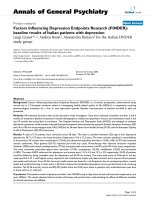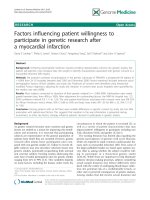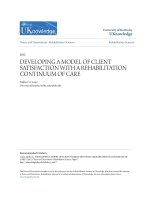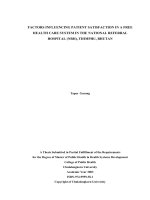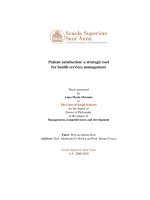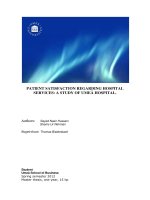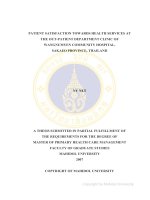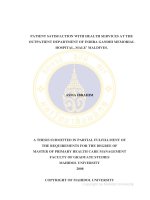Luận Án TS y học: Factors influencing patient satisfaction in a free health care system in the national referral hospital (NRH), Thimphu, Bhutan
Bạn đang xem bản rút gọn của tài liệu. Xem và tải ngay bản đầy đủ của tài liệu tại đây (1.92 MB, 143 trang )
FACTORS INFLUENCING PATIENT SATISFACTION IN A FREE
HEALTH CARE SYSTEM IN THE NATIONAL REFERRAL
HOSPITAL (NRH), THIMPHU, BHUTAN
Tapas Gurung
A Thesis Submitted in Partial Fulfillment of the Requirements
for the Degree of Master of Public Health in Health Systems Development
College of Public Health
Chulalongkorn University
Academic Year 2003
ISBN-974-9599-38-1
Copyright of Chulalongkorn University
Thesis Title
: Factors Influencing Patient Satisfaction in a Free Health Care
System in The National Referral Hospital (NRH), Thimphu,
Bhutan
By
: Tapas Gurung
Program
: Health Systems Development
Thesis Advisor
: Robert Sedgwick Chapman, M.D., M.P.H.
Accepted by the College of Public Health, Chulalongkorn University, Bangkok
Thailand in Partial Fulfillment of the Requirements for the Master's Degree
…………………………… Acting Dean of the College of Public Health
(Associate Professor Prida Tasanapradit, M.D.)
THESIS COMMITTEE
………………………………………………………….. Chairman
(Associate Ong-arj Viputsiri, M.D., Dr.P.H.)
…………………………………………………...……… Thesis Advisor
(Robert Sedgwick Chapman, M.D., M.P.H.)
…………………………………………..………………. Member
(Associate Professor Buddhagarn Rutchatorn, Ph.D.)
…………………………………………..………………. Member
(Professor Edgar J. Love, M.D., Ph.D.)
iii
PH: 032393
: MAJOR HEALTH SYSTEMS DEVELOPMENT
KEY WORDS : INPATIENT SATISFACTION / DOMAINS OF CARE / ALL
WARDS / THE NRH
TAPAS GURUNG: FACTORS INFLUENCING PATIENT SATISFACTION
IN A FREE HEALTH CARE SYSTEM IN THE NATIONAL REFERRAL
HOSPITAL, THIMPHU, BHUTAN. THESIS ADVISOR: ROBERT
SEDGWICK CHAPMAN, M.D., M.P.H., 130 pp. ISBN 974-9599-38-1
Apparent rise in patient dissatisfaction at The National Referral Hospital at Thimphu,
Bhutan, warranted a study to find out levels and factors for dissatisfaction. A cross
sectional hospital-based study was conducted involving 180 inpatients from all wards
and cabins in January-February 2004. An interviewer administered questionnaire
survey on patients, 5 key informants were interviewed and a short questionnaire survey
of physicians were conducted. Mostly young, both genders represented equally, 61.1%
of study population was illiterate. 66.1% was poor with a monthly income below
Ngultrum 5000 (about US$110), 35% were farmers and though a referral hospital, 56%
patients were self-admitted patients mainly for acute conditions (58.3%). Overall, there
were 91.7% satisfied and 8.3% dissatisfied patients. Among wards, the cabin had the
highest overall satisfaction at 66.7%, followed by EENT, surgical and maternity at
64.7%, 62.1% and 60.0% respectively. Wardwise differences were statistically
significant (p=0.029). Age, ethnicity and duration of hospital stay had statistically
significant association with accessibility (p=0.003, 0.041 and 0.014 respectively);
referral status and admission history with comfort in ward (p=0.026 and 0.021
respectively). Gender, referral status and admission history had significant associations
with waiting time (p=0.047, 0.009 and 0.007 respectively). Nurses’ competence and
ethnicity had significant associations with disease status and doctor patient relationship
(p=0.046 and 0.045 respectively). Provider-related domains were more important for
patient satisfaction than were hospital milieu-related domains (p <0.001). Free health
care, kind and helpful staff, their competencies, good nursing and medical care,
reputation of this apex hospital were some of the main factors for satisfaction. Visitor
restrictions, long waiting time, inadequate communication between physicians and
patients were some of the factors highlighted for dissatisfaction. Lack of adequate staff
was identified as one of the main bottlenecks for the NRH in not being able to meet
patients’ expectations. Lack of staff also impeded physicians from practicing “Service
with a Humane Face”. Encouraging a good doctor-patient relationship, reviewing
visitor restriction rules and hospital diet, and provision of a decent resting place for
patient attendants/companions at night were some of the main recommendations worth
considering.
Field of study Health Systems Development Student’s signature
Academic year 2003
Advisor’s signature
iv
ACKNOWLEDGEMENTS
This academic work would not have been accomplished without the support and
guidance of a number of persons. I hereby extend my sincere and most humble
acknowledgements and thanks to all concerned with special mention of the following.
I would like to thank Ajarn Ong-arj Viputsiri, chairman of my thesis committee, Dr.
Robert S. Chapman, my thesis advisor, Ajarn Buddhagarn Rutchatorn, my external
examiner, Ajarn Sathirakorn Pongpanich and Professor Edgar J. Love, committee
members for consenting to be my mentors and guides in this maiden venture of mine in
research.
I would also like to extend my heartfelt thanks to the Royal Government of Bhutan for
giving me this opportunity to pursue a masters course in the prestigious College of
Public Health, Chulalongkorn University, Bangkok. I will always persevere to serve my
country and the Bhutanese people to the best of my abilities and with most sincere
efforts for the rest of my career.
I will fail in my duty as a student here if I do not mention and thank all those faculty
members who taught me with diligence and love. I hope that what I do in the domain of
public health in future, in my own small ways will be significant (with p<0.05) and I
will definitely attribute those to all of you too. The assistances of the ever cheerful and
helpful administrative and other support staff here will always be remembered. I will
cherish my days here and try and live up to the lofty goals and visions of this institute.
My sincere thanks go also to all those who facilitated me in this research work
including the staff and inpatients and patient attendants of the National Referral
Hospital, Thimphu. I hope this small research of mine will be of some use to you in
some ways.
To all my friends of this MPH cohort, my thanks for sharing many things beyond the
academic confines of CPH. I will always try to remember and reminisce our days
together and I wish you the best in all your ventures in life.
I would also like to make a special mention and acknowledge the support from all my
Bhutanese friends at Rangnam apartment and elsewhere studying at various institutions
here at Bangkok. Our days together will always be remembered down memory lane.
And lastly, I would like to thank my wife, three children and other near and dear ones
for their moral and other valuable support. I will make sincere efforts to make up for
the twelve months we all missed one another.
TABLE OF CONTENTS
Page
ABSTRACT
iii
ACKNOWLEGDEMENTS
iv
TABLE OF CONTENTS
v
LIST OF TABLES
x
LIST OF FIGURES
xii
ABBREVIATIONS
xiii
CHAPTER I
INTRODUCTION
1
1.
Background
1
2.
Problem Identification
4
3.
The Research Questions
6
4.
Rationale of the Research
6
5.
Purpose of the Research
7
6.
Objectives of the Research
8
7.
Conceptual Framework
9
8.
Operational Definitions of Variables
CHAPTER II
LITERATURE REVIEW
12
13
1.
Introduction
13
2.
Literature Related to Patient Satisfaction
14
3.
Some Models and Theories of Patient Satisfaction
15
vi
4.
Literature Review Related to Doctor–Patient Relationship
21
5.
Literature Review of Factors in Relation to Patient Satisfaction
26
CHAPTER III RESEARCH METHODOLOGY
30
1.
Introduction
30
2.
Measurement Methods
33
3.
Time Line for Data Collection
33
4.
A Brief Description of the National Referral Hospital
(NRH) the Site of Research
34
5.
Target Population
35
6.
Sampling Technique
35
7.
Inclusion Criteria
35
8.
Exclusion Criteria
35
9.
Study / Sample Population
36
10. Validity Testing of Questionnaires
36
11. Reliability Testing of Questionnaires
36
12. Training of Data Collectors/Survey Interviewers
37
13. Ethical and Administrative Clearances
37
14. Data Collections and Analysis
38
15. Analysis of the Research
39
16. Limitation of the Study
39
17. Benefits of the Study
40
vii
CHAPTER IV RESEARCH FINDINGS
41
1.
Introduction
41
2.
Salient Features of Study Findings
41
3.
Satisfaction Ratings
45
4.
Levels of Satisfied and Dissatisfied Patients
58
5.
Factors for Satisfaction as Responded by Satisfied Patients
62
6. Recommendations from the Satisfied Group of Patients
for Improving Services and Patient Satisfaction
7.
64
Factors for Dissatisfaction for Dissatisfied Group of Patients
65
8. Tests of Associations Between Socio-Demographic Factors
and Specific Domains of Satisfaction
66
9. Associations Between Patient Factors and Service
Domains Under Provider Aspect
71
10. Associations Between Patient Factors and Overall
Satisfaction in Both Aspects
11. Overall Satisfaction with Age and Duration of Hospital Stay
72
73
11. Test of Differences in Terms of Satisfaction Between
Factors Under Hospital Milieu and Provider Aspects
13. Interviews with Key Informants
74
75
14. Findings of the Self-Administered Questionnaire Survey
of Physicians at the NRH
78
viii
CHAPTER V
DISCUSSIONS, CONCLUSIONS,
RECOMMENDATIONS
82
1.
Introduction
82
2.
Salient Socio-Demographic Characteristics of Sample Population
83
3.
Summary of Satisfaction Levels of Different Services
in the Wards of NRH as Rated by Study Population
86
4.
Salient Features of Dissatisfied Patients in the NRH.
91
5.
Factors for Satisfaction
93
6.
Factors for Satisfaction as Responded by Satisfied Patients
99
7.
Scores for Various Services Among Dissatisfied Group of Patients
99
8.
Factors for Dissatisfaction Among the Dissatisfied Patients
9.
Recommendations for Improvement as Suggested
by Satisfied Patients
10. Interviews of Key Informants
100
100
101
11. Questionnaire Survey of Physicians on their Perceptions
of Patient Satisfaction at the NRH.
12. Discussions on Some Factors/Variables Under Certain Domains
CONCLUSIONS
102
103
106
1.
Sample Features
106
2.
Satisfaction Levels in the NRH.
106
3.
Satisfaction Levels for Different Service Domains at Different Wards
107
4.
Factors for Satisfaction
107
5.
Factors for Dissatisfaction as Responded by Dissatisfied Patients
108
ix
6.
Recommendations for Improvement of Inpatient Services
and Patient Satisfaction
109
7.
Summary of the Interviews with Key Informants
109
8.
Questionnaire Survey of Physicians at the NRH.
109
9.
Some Limitations of the Study
110
RECOMMENDATIONS
112
1.
General recommendations
112
2.
Specific to the NRH.
113
REFERENCES
115
ANNEXES
ANNEX I
Questionnaires for Structured Interview Survey
of Inpatients of Thimphu General Hospital (TGH)
119
ANNEX II
Informed Consent Form
123
ANNEX III
Questionnaires for physicians’ survey at the
National Referral Hospital (NRH), Thimphu
ANNEX IV
124
Outline of topics for interviews with key informants of the
Department and National Referral Hospital at Thimphu, Bhutan. 127
ANNEX V
Budget estimate
128
ANNEX VI
129
BIOGRAPHY
130
x
LIST OF TABLES
Page
Table 1:
Operational definition of variables
12
Table 2:
Age distribution of study population
42
Table 3:
Duration of hospital stay (in days) during time of survey
42
Table 4:
Socio-demographic characteristics of sample population
43
Table 5:
Satisfaction levels for whole sample population
46
Table 6:
Satisfaction levels in the Eye, Ear, Nose and Throat ward
47
Table 7:
Satisfaction levels in medical ward
48
Table 8:
Satisfaction levels in the orthopedic ward
49
Table 9:
Satisfaction levels in the maternity ward
50
Table 10: Satisfaction levels in the surgical ward
52
Table 11: Satisfaction levels in pediatric ward
53
Table 12: Satisfaction levels in the cabin
54
Table 13: Ward wise satisfaction matrix for hospital milieu,
provider factors and overall combined
56
Table 14: Table showing ward-wise distribution of satisfied
and dissatisfied patients
59
Table 15: Characteristics of dissatisfied patients
60
Table 16: Scores for service domains for dissatisfied patients
61
Table 17: Tests for differences in means of satisfaction scores between
satisfied and dissatisfied patients in hospital
and provider domains and overall satisfaction
62
Table 18: Factors for satisfaction as responded by satisfied patients
63
xi
Table 19: Recommendations from the satisfied group
64
Table 20: Factors for dissatisfaction for dissatisfied patients
65
Table 21: Associations between age, ethnicity and duration
of admission with accessibility
66
Table 22: Association between gender, referral status
and admission history with waiting time
68
Table 23: Association between Referral status and Admission
history with Comfort in the ward
69
Table 24: Disease status with nurses’ competency
71
Table 25: Ethnicity with Doctor-patient relationship
71
Table 26: Association between age and overall satisfaction
with domains under provider aspect
Table 27: Association between Age and Overall combined satisfaction
72
73
Table 28: Association between duration of admission
and overall combined satisfaction
74
Table 29: Test of differences between means of scores
under hospital milieu and provider aspects
75
Table 30: Distribution of physicians specialty/ward wise for
the questionnaire survey
79
xii
LIST OF FIGURES
Page
Figure 1: Graph patient referrals and expenditure 1992-2002 in NRH1
3
Figure 2: Conceptual frame work of research
9
Figure 3: Aday and Anderson Model
16
Figure 4: Cognition-Affect Model of Satisfaction
18
Figure 5: Zone of Tolerance by Nelson E. and Larson C.
19
Figure 6: The Making of Patient Satisfaction Happen
20
Figure 7: Patient flow in the National Referral Hospital (NRH)
34
xiii
ABBREVIATIONS
BHUs
: Basic Health Units
EENT
: Eye, Ear, Nose and Throat
GNH
: Gross National Happiness
GNP
: Gross National Product
GDP
: Gross Domestic Product
JDWNRH
: Jigmi Dorji Wangchuck National Referral Hospital
(NRH in short)
Khengpas
: The Central Bhutanese people
Lhotshampas : The Southern Bhutanese people
MOH
: Ministry of Health
Ngalongs
: The Western Bhutanese people.
Nu.
: Ngultrum, the Bhutanese currency (US $ 1= Nu. 46)
ORCs
: Out Reach Clinics
PHC
: Primary Health Care
RGOB
: Royal Government of Bhutan
Sharchops
: The Eastern Bhutanese people
CHAPTER I
INTRODUCTION
1. Background
Bhutan, a small land locked country in the Himalayas pursues a lofty philosophy of
Gross National Happiness (GNH) as the overarching developmental philosophy (Vision
2020, 2000). This is contrary to the conventional Gross National Product (GNP) or
Gross Domestic Product (GDP) that most countries follow for development and
achieving economic goals. This philosophy emphasizes the wholesome development of
Bhutanese society taking into considerations economic, social, psychological and even
spiritual dimensions of development. The strategies engaged towards fulfillment of this
utopian goal of GNH are economic development, environmental preservation, cultural
promotion and good governance (Gross National Happiness, 1999, The Center for
Bhutan Studies). This is again not to undermine economic gains, which are equally
important for Bhutan whose GDP stands at about US $500 per person. Through this
concept, the Royal Government of Bhutan (RGOB) strives to provide basic essential
services in the social sectors like health and education freely to all Bhutanese citizens.
Health care services in Bhutan are still in a fledgling stage. An independent Ministry of
Health (MOH) was constituted on 26th June 2003. Before that it was the Ministry of
Health and Education. Primary Health Care (PHC) is the strategy for health care
2
delivery based on the Alma Ata declaration in 1978 with particular emphasis on
decentralization and integration of activities up to community level. These are
implemented through an equitably distributed network of 29 hospitals, 166 Basic
Health Units (BHUs), one traditional (indigenous) hospital and 19 dispensaries, and
about 455 outreach clinics. As of now, primary health coverage stands at about 90%
and an army of about 1450 health workers across Bhutan is striving to achieve the
remaining 10%.
No private practices exist in the country and the only alternative medicine; the
indigenous system is integrated with general medical care services. Medical care, at all
levels is free for the Bhutanese except for some advanced technology-based
interventions like crown and bridge procedures in dentistry and laproscopic surgeries in
Jigme Dorji Wangchuck National Referral Hospital (JDWNRH), The National Referral
Hospital in short. With a minimal 2% deduction as health contribution from monthly
salary of government servants, government even pays for cost of treatment outside in
India and Thailand. The referral cost incurred mainly for tertiary care has spiraled from
US $ 2.9millions in 1992-93 to US $11.3 millions by 2001-002.
3
Patients referral and expenditure 1992 - 2002
800
11.3
700
8.2
600
300
3.9
246
2.6
384
232
690
4.8
3.4
2.9
200
100
10.4
5.9
500
400
9.4
418
445
545
593
541
243
0
19921993
19931994
19941995
19951996
No. of cases
19961997
19971998
19981999
19992000
20002001
20012002
Expenditure in million $
Source: The National Referral Hospital, 2003.
Figure 1: Graph patient referrals and expenditure 1992-2002 in NRH1
By and large, most Bhutanese health care seekers are simple and law-abiding people
reposing full trust on care providers who are educated and also employed by the state.
The overall motto of service delivery to our people is consonant with the principles of
“Professionalism” and “Service With Humane Face”. However, there are indications
that certain sections of people in the capital city, Thimphu are no longer satisfied and
happy with whatever free health care the government is providing to them.
These expressions are appearing in the media and as anecdotal evidences from people
we know and interact within Thimphu, which is a small town. For example in AprilMay and August 2003, two topics as “Wrong Diagnosis” and “Doctors Hate Patients”
4
respectively made national headlines in the electronic media engaging a wide spectrum
of Bhutanese elites in the debate. Both these complaints originated from The National
Referral Hospital in Thimphu. These incidences disturb and frustrate the ministry,
department of health including the rank and file of health personnel who are doing their
best to render services despite limitations and constraints.
2. Problem Identification
The apparent rising trend of patient dissatisfaction in a free health system as in The
NRH in Thimphu is a concern for policy makers and administrators in the ministry and
departments of health. The royal government is spending a substantial amount of
money for health care at all levels of services including tertiary care for referred
treatment even outside the country. As a developing country, resources are limited and
there are competing priorities at national level. The amount of budgetary resources
allocated to social sectors to the tune of about 10-12% yearly bears testimony to the
fact that health is high on the development agenda of Bhutan. Most countries in the
South East Asia region have an allocation of 2-8% of gross domestic product for health
sector (Than Sien, 2001). The best use of resources and to cater services to the
satisfaction of general public is one of the overriding development objectives of health
sector.
Geopolitically, Bhutan, a small nation with an area of 47,000 square kilometers and a
population of about 700,000, lies sandwiched between two Asian giants; India in the
south and China in the north. It is a paramount national goal for the government to keep
her people satisfied and happy conforming to the philosophy of Gross National
5
Happiness. National solidarity, in essence, is a goal for Bhutan’s very survival and as a
strategy towards this; satisfaction and happiness of the public are dear objectives of all
social sectors of the Bhutanese government.
Bobadella et al (1992) said that no country in the world can provide health care services
to meet all the needs of the population. However, the kingdom of Bhutan aspires to take
the challenges of providing these and that too freely to her citizens.
The problem of patient dissatisfaction may not be substantial and there have been no
surveys or studies carried out to ascertain this. Also it has been difficult to pinpoint as
to which categories of patients are complaining regarding the services. Few instances of
grievances had focused both inpatient and outpatient services. The few complaints
represent only the tip of the iceberg as only 4% of those dissatisfied patients complain
(Roderick M. McNealy, 1994). There may be, therefore, quite a number of dissatisfied
patients in town and elsewhere harboring bad experiences regarding health services at
the NRH. And what happens at Thimphu spreads fast and wide to the districts with
even possible backlash on patient referral to this pioneer hospital. The fact this has
started warrants us to initiate and find out the factors and service areas related to patient
dissatisfaction for initiating timely and necessary administrative and policy changes.
The attempt to study the issues and factors related to patient satisfaction is also a
testimony that we care for their needs and expectations.
6
3. The Research Questions
The following are some of the research questions related to the issues of patient
dissatisfaction:
3.1
What are the socio-demographic characteristics of patients at the NRH?
3.2
Are there marked differences in quality of services and satisfaction levels
among inpatients of different wards of NRH?
3.3
What is the level of dissatisfaction among inpatients of NRH?
3.4
What are the main factors that determine patient satisfaction in the
Bhutanese context?
3.5
What are the perceptions of physicians, policy makers and administrators
about issues of patient dissatisfaction?
4. Rationale of the Research
The following are the rationale for the research:
4.1
Patient satisfaction is a measure of quality of health services (Donabedien,
1966). Quality assessment and satisfaction are often used interchangeably
though, as per Bitner M. and Hubbert A. (1994) satisfaction is generally
considered in a broader term.
4.2
Patient satisfaction is an indicator of patient and health provider
relationship. In our system too as elsewhere, a congenial health provider
and patient relationship is crucial for the satisfaction of the latter. Ware
and Davis (1993) said that satisfaction is a cementing process that binds a
patient and the health care provider. This bond can be used as one of the
7
predictors whether patients are likely to continue or change their health
care providers.
4.3
Patient satisfaction increases likelihood of compliance to treatment and
better follow up of patient care (Wilson P., McNamara, 1982).
4.4
Patient satisfaction may also lead to provider satisfaction and motivation
to work better. Tzeng Huey-Ming (2002) found a positive relationship
between these two parameters in a study among nurses in a Taiwan
teaching hospital. In an altruistic sense, this is important in our system as
there are no private practices and patient satisfaction may be an important
factor for job satisfaction for our physicians and health care workers.
4.5
Roderick M. Mc Nealy in his book Making Customer Satisfaction Happen
says that only 4% of dissatisfied patients complain. The other 96 % walk
away quietly. Hence, the few instances of complaints represent only the
tip of iceberg of dissatisfied population among the clientele base of this
hospital.
5. Purpose of the Research
The main purpose of the study was to assess level of dissatisfaction among inpatients of
NRH and to ascertain the main factors for satisfaction/dissatisfaction in a free health
care system in the Bhutanese context. And ultimately, this would be used to improve
patient care, patient satisfaction and utilization of inpatient services at NRH.
8
6. Objectives of the Research
6.1
General:
To provide a scientific basis for formulating quality and satisfaction related policies and
strategies for improving service utilization at NRH.
6.2
Specific objectives
6.2.1
To describe the socio-demographic characteristics of inpatients in
NRH.
6.2.2
To characterize patient satisfaction levels in respect to different
service domains in all wards of NRH.
6.2.3
To find out the level of dissatisfaction among inpatients of NRH.
6.2.4
To ascertain the main factors that influence patient satisfaction
among inpatients in NRH.
6.2.5
To find out perceptions of physicians, hospital administrators and
department policy makers in terms of patient satisfaction or
dissatisfaction, quality and sustainability of health care services in
NRH.
6.2.6
To seek recommendations for specific factors or service areas for
improvement from inpatients and physicians of NRH.
9
7. Conceptual Framework
Policy/ Infrastructure
Gross National Happiness
Government Commitment
Absence of Private Practices
No Alternative Medicine
Free Health Care
Patient Factors
Age, Gender, Occupation, Income
Education, Ethnicity
Referral Status, Disease Type
Admission History
Duration of Admission
Patient Satisfaction
Provider Factors
Service with Humane Face
Doctor-patient Relationship
Attitude of Care Providers
Comprehensive Care
Competence
Hospital Milieu
Attitude of Support Staff
Accessibility, Waiting Time
Social Support
Cleanliness
Comfort, Diet
Figure 2: Conceptual frame work of research
Increased Health
Services
Utilization
10
7.1
Variables in the Conceptual Framework
These were divided into Dependent and Independent variables as follows:
7.1.1
Dependent Variable
The Dependent Variable was Patient Satisfaction.
These were divided under two broad domains as follows:
7.1.1.1
Factors under Hospital Milieu domain
These were as follows:
•
Accessibility- pertained to services, location, and access for
admission.
•
Cleanliness – pertained to wards, toilets, bathrooms.
•
Waiting Time- pertained to length and quality.
•
Attitude of Support Staff – Ward boys, cooks and sweepers.
•
Comfort in the Ward- light, ventilation, noise control etc.
•
Hospital Diet- quality, quantity, timing.
•
Social Support- pertained to visitors/attendants and visiting
times.
7.1.1.2
•
Factors under Provider domain
Competence of Health Providers – pertained to doctors and
nurses
•
Doctor-patient Relationship
•
Attitude of care providers (Doctors and nurses)
•
Comprehensive Care
•
Service with Humane Face (kind, caring, sympathetic)
11
7.1.2
Independent Variables
These were patient socio-demographic characteristics as below.
•
Gender
•
Age
•
Occupation
•
Education
•
Income
•
Ethnicity
•
Referral status- self referred/admitted or referred as per referral
policies.
•
Type of disease- acute or chronic.
•
Duration of hospital stay
•
Admission history - first time or repeat admission
The Policy and Infrastructure domains, which consisted of the driving and enabling
forces or factors in our health system among independent variables, were not included
for the study.
12
8. Operational Definitions of Variables
Table 1: Operational definition of variables
VARIABLES
OPERATIONAL DEFINITIONS
Patient/Consumer
Demographic and socio-economic features of
Factors
Independent
inpatients
that
have
relationship
with
satisfaction.
Patient
Proportion/levels of inpatients’ expectations
Satisfaction
fulfilled in regards to health care services in
NRH in respect to the following.
Dependent
1. Hospital Milieu
Inpatient environment that facilitates smooth
service
delivery
leading
to
inpatient
satisfaction.
2.Provider Factors Qualities or values in doctors and nurses that
affect satisfaction levels of inpatients.

